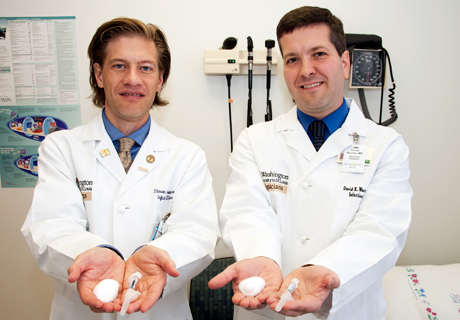
How to handle the flu: Steven J. Lawrence, MD, and David K. Warren, MD, recommend two lines of defense against the virus — germ-killing foam and vaccinations.

How to handle the flu: Steven J. Lawrence, MD, and David K. Warren, MD, recommend two lines of defense against the virus — germ-killing foam and vaccinations.
Headlines about influenza range from informative to downright scary. But the truth about the new H1N1 virus lies somewhere in the middle of all the hype. All influenza viruses, including the 2009 H1N1 strain, can cause significant serious illnesses: On average, 36,000 Americans die each year from flu and its complications; another quarter of a million are hospitalized. An informed, cautious approach is warranted; at Washington University and its medical center, physicians, administrators and other health professionals are working with health agencies to meet this challenge head on.
The 2009 H1N1 flu virus, which first appeared this past spring, has several characteristics that differentiate it from typical seasonal flu viruses. One is that, unlike seasonal flu, which is active when the weather is cool and dry but dies down in the warmer summer months, the new H1N1 virus remained active over the summer. The other, more significant differences are its possible scope and the portion of the population it will affect.
Because the 2009 H1N1 seems to contain some components similar to a flu virus that was circulating before 1957, people who were alive at that time and exposed to the earlier virus may have some immunity. That means that children and younger adults are the new virus’ prime targets.
Steven J. Lawrence, MD, assistant professor of medicine and associate director of emergency response planning for Washington University’s Midwest Regional Center for Excellence in Biodefense and Emerging Infectious Diseases Research (MRCE), has been involved with pandemic flu preparedness since an influenza task force was established three years ago at the School of Medicine.
“Even though mortality and hospitalization rates for the 2009 H1N1 virus seem to be pretty similar to those for seasonal flu, the burden of it has shifted toward younger adults and kids,” says Lawrence. “That’s the big difference with H1N1 from a clinical standpoint.”
Because the virus was clearly still causing illness during the typically dormant summer months, health professionals like Lawrence and health agencies that track influenza suspected and have now confirmed a higher number of cases occurring this fall, which is understandable as people begin to spend more time together indoors.
“We are seeing an early return of H1N1 in fairly large numbers,” says Lawrence. “At this point, there is no evidence that suggests it’s going to be more severe than we’ve seen so far on an individual basis, but since no one’s seen this virus before, we do anticipate there will be more cases of flu caused by this virus than we would see in a typical year.”
Those assumptions are the basis of the preparatory work being done at Washington University. Much of that work involves working closely with health care partners Barnes-Jewish Hospital, St. Louis Children’s Hospital and BJC HealthCare to keep patients, students, faculty and staff apprised of new information about the flu and access to vaccines.
David K. Warren, MD, assistant professor of medicine, is the medical director for infection control at Barnes-Jewish Hospital. In that role, he is involved in the planning of vaccine and infection control prevention messages with the medical school community. That includes coming up with policies for handling patients who come into clinics with flu-like illness.
“The goal from our side is limiting exposure,” says Warren. “That may include making sure that patients wear masks, if they have flu symptoms, as soon as they come into the medical center and that people use appropriate hygiene, such as hand washing and cough etiquette.”
Warren feels that caution is reasonable, given the concerns about seeing more influenza in the community than is typical.
“One of our goals is to work closely with Barnes-Jewish Hospital, St. Louis Children’s Hospital and BJC HealthCare to make sure the information we are putting out is uniform,” says Warren. “In that way, we can address patient concerns, student concerns and clinicians’ questions.
A key to keeping 2009 H1N1 at bay will be its vaccine, which became available to high-risk groups, such as pregnant women, infants and children, and people with chronic health conditions, starting in October. Another of the high-priority groups for receiving the vaccine is health care and emergency medicine personnel who have direct contact with patients or infectious materials. For that reason, School of Medicine infectious disease experts are working with local health departments to develop plans for the distribution of the 2009 H1N1 vaccine.
James P. Crane, MD, associate vice chancellor for clinical affairs and chief executive officer of the Faculty Practice Plan, says vaccination is sound medical policy. “It protects the health of our employees and their families and also protects our patients from becoming severely ill.”
Other efforts to meet this year’s flu challenge are underway at the medical center: St. Louis Children’s Hospital, experiencing a high volume of patients due to flu-like symptoms, has erected two tents in the valet area of its visitor parking garage to treat emergency unit overflow patients.
The goal of all of these efforts by the School of Medicine, Barnes-Jewish Hospital and St. Louis Children’s Hospital is the same: to provide the best possible care to the patients and families we serve.